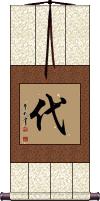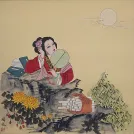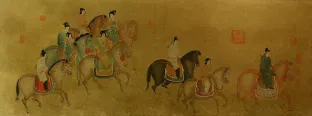Many custom options...
And formats...

Dynasty in Chinese / Japanese...
Buy a Dynasty calligraphy wall scroll here!
Dynasty
代 is the word used to designate dynasties in Asia.
代 alone can mean generation; age; period; historical era; eon; world; society; reign; era. 代 comes after the name of the dynasty, for example, the Tang Dynasty is the “Tang Dai” in Chinese.
Some have suggested that the word dynasty comes from the Chinese word “dai” (as “dai” sounds like the first syllable of a dynasty). However, the word dynasty is derived from the Greek word δυναστεία (dunasteia) meaning lordship and/or domination.
Sometimes this word is used in a different context where it can mean to represent or substitute. In this case, it can mean representative of; on behalf of; acting for, e.g. to offer incense in place of another.
In ancient Japan, this could also be a “shiro” (a unit of land area equal to one-fiftieth of a tan or about 20 square miles).
This in-stock artwork might be what you are looking for, and ships right away...
Gallery Price: $107.00
Your Price: $59.00
Gallery Price: $150.00
Your Price: $79.88
Gallery Price: $180.00
Your Price: $99.88
These search terms might be related to Dynasty:
A House Might Be Worth 1 Million Dollars, but Good Neighbors Are Worth 10 Million
Bless This House
Confucius: Golden Rule / Ethic of Reciprocity
Empire
Family / Home
Family / Household
Family / Members of a Family
Family and Friends
Family Bond / Family Ties
Family Love
Family Love / Domestic Bliss
Family Over Everything
Forever Family
Gecko / House Lizard
Golden Rule
Happy Family
House of Good Fortune
House of Red Delights
Line
Love the House and Its Crow
Marie-Line
One Family Under Heaven
Safety and Well-Being of the Family
Not the results for dynasty that you were looking for?
Below are some entries from our dictionary that may match your dynasty search...
| Characters If shown, 2nd row is Simp. Chinese |
Pronunciation Romanization |
Simple Dictionary Definition |
代 see styles |
dài dai4 tai dai だい |
More info & calligraphy: Dynasty(n,n-suf) (1) charge; cost; price; (n,n-suf) (2) generation; age; (school) year; cohort; reign; (n,n-suf) (3) {geol} era; (n,n-suf) (4) (after someone's name or title) a representative of; on behalf of; for (someone); (n,n-suf) (5) (used after a phone number) (See 代表電話番号) switchboard number; (counter) (6) counter for decades of ages, eras, etc.; (counter) (7) counter for generations (of inheritors to a throne, etc.); (counter) (8) (abbreviation) (See 代理申請会社) proxy application company; (9) (abbreviation) (used in dictionaries, etc.) (See 代名詞・1) pronoun; (surname) Daisaki Instead of, in place of, acting for, for; e. g. 代香 to offer incense in place of another; a generation, v. 世代. |
周 see styles |
zhōu zhou1 chou shuu / shu しゅう |
More info & calligraphy: Chow / Zhou(counter) (1) counter for laps or circuits; (2) {math} perimeter; (3) (hist) Zhou dynasty (of China; approx. 1046-256 BCE); Chou dynasty; (female given name) Meguru Around, on every side, complete. |
唐 see styles |
táng tang2 t`ang tang tou / to とう |
More info & calligraphy: Donn(1) (hist) Tang dynasty (of China; 618-907); T'ang dynasty; (2) (archaism) China; foreign country; (surname) Touzaki for nothing |
旅 see styles |
lǚ lu:3 lü ryo りょ |
More info & calligraphy: Journey / Travel(hist) 500-man battalion (Zhou dynasty Chinese army); (surname) Taya |
明 see styles |
míng ming2 ming mei / me めい |
More info & calligraphy: Light / Bright(1) (ant: 暗) brightness; (2) discernment; insight; an eye (for); (3) (See 明を失う) eyesight; vision; (prefix) (4) (abbreviation) (See 明治) nth year in the Meiji era (1868.9.8-1912.7.30); (surname) Meishuu vidyā, knowledge. ming means bright, clear, enlightenment, intp. by 智慧 or 聰明 wisdom, wise; to understand. It represents Buddha-wisdom and its revelation; also the manifestation of a Buddha's light or effulgence; it is a term for 眞言 because the 'true word' can destroy the obscurity of illusion; the 'manifestation' of the power of the object of worship; it means also dhāraṇīs or mantras of mystic wisdom. Also, the Ming dynasty A. D. 1368-1644. |
梁 see styles |
liáng liang2 liang ryou / ryo りょう |
More info & calligraphy: Leung(hist) Liang dynasty (of China; 502-557); (surname) Reon pillar |
泰 see styles |
tài tai4 t`ai tai tai(p); tai タイ(P); たい |
More info & calligraphy: Ty(kana only) Thailand; (given name) Yutaka The Ch'in state and dynasty 255-205 B. C.; Prosperous, exalted; many. |
清 see styles |
qīng qing1 ch`ing ching shin しん |
More info & calligraphy: Clarity(hist) Qing dynasty (of China; 1644-1912); Ch'ing dynasty; Manchu dynasty; (personal name) Seiji |
秦 see styles |
qín qin2 ch`in chin shin; hatashin しん; はたしん |
More info & calligraphy: Qin / Chin / Tan / Yasushi(hist) Qin dynasty (of China; 221-207 BCE); Ch'in dynasty; (surname) Yasushi a fine strain of rice |
虢 see styles |
guó guo2 kuo |
More info & calligraphy: Guo |
金 see styles |
jīn jin1 chin kin きん |
More info & calligraphy: Gold / Metal(1) gold (metal); (2) (See 金色) gold (color); (3) gold (medal); first place (prize); (noun - becomes adjective with の) (4) something of great value; something golden (e.g. silence); (5) money; gold coin; (6) (written before an amount of money) sum (of money); (7) (abbreviation) (See 金曜) Friday; (n,ctr) (8) karat (measure of purity of gold); carat; (9) (See 五行・1) metal (fourth phase of Wu Xing); (10) (hist) Jin dynasty (of China; 1115-1234); Chin dynasty; Jurchen dynasty; (11) (abbreviation) {shogi} (See 金将) gold general; (12) (abbreviation) (colloquialism) (See 金玉) testicles; (surname) Kimu; Kim hiraṇya, 伊爛拏 which means cold, any precious metal, semen, etc.; or 蘇伐刺 suvarṇa, which means "of a good or beautiful colour", "golden", "yellow", "gold", "a gold coin", etc. The Chinese means metal, gold, money. |
陳 陈 see styles |
chén chen2 ch`en chen chin ちん |
More info & calligraphy: Tran(1) (hist) Chen (ancient Chinese state; approx. 1045-479 BCE); Ch'en; (2) (hist) Chen dynasty (of China; 557-589 BCE); Ch'en dynasty; (surname) Tran Arrange, marshal, spread, state; old, stale. |
劉備 刘备 see styles |
liú bèi liu2 bei4 liu pei ryuubi / ryubi りゅうび |
More info & calligraphy: Liu Bei(person) Liu Bei (161-223) |
南京 see styles |
nán jīng nan2 jing1 nan ching nankin ナンキン |
More info & calligraphy: Nanjing(1) Nanjing (China); Nanking; (2) (ksb:) (See カボチャ) pumpkin; squash; (prefix noun) (3) Chinese; Southeast Asian; foreign; (prefix noun) (4) rare; precious; cute; (place-name) Nanking (China); Nanjing |
印度 see styles |
yìn dù yin4 du4 yin tu indo いんど |
More info & calligraphy: India(ateji / phonetic) (kana only) India; (place-name) India 印特伽; 身毒; 賢豆; 天竺 Indu (meaning 'moon' in Sanskrit), Hindu, Sindhu; see also 信度 and 閻浮 India in general. In the Tang dynasty its territory is described as extending over 90, 000 li in circuit, being bounded on three sides by the sea; north it rested on the Snow mountains 雪山, i. e. Himālayas; wide at the north, narrowing to the south, shaped like a half-moon; it contained over seventy kingdoms, was extremely hot, well watered and damp; from the centre eastwards to 震旦 China was 58, 000 li; and the same distance southwards to 金地國, westwards to 阿拘遮國, and northwards to 小香山阿耨達. |
司徒 see styles |
sī tú si1 tu2 ssu t`u ssu tu shito しと |
More info & calligraphy: Stu(hist) (See 六卿) Minister of Civil Administration and Social Welfare (Zhou dynasty China) |
司馬 司马 see styles |
sī mǎ si1 ma3 ssu ma shiba しば |
More info & calligraphy: Sima(hist) (See 六卿) Minister of War (Zhou dynasty China); (given name) Shime |
啟蒙 启蒙 see styles |
qǐ méng qi3 meng2 ch`i meng chi meng |
More info & calligraphy: Enlightenment |
安息 see styles |
ān xī an1 xi1 an hsi ansoku あんそく |
More info & calligraphy: Sleep / Rest / Repose(n,vs,vi) rest; repose (安息國) Parthia, 波斯 modern Persia, from which several monks came to China in the later Han dynasty, such as 安世高 An Shigao, 安玄 Anxuan, 曇無諦 Tan Wudi, 安法欽 An Faqin, 安淸 Anqing.; To rest. |
岳飛 岳飞 see styles |
yuè fēi yue4 fei1 yüeh fei gakuhi がくひ |
More info & calligraphy: Yue Fei(personal name) Gakuhi |
班固 see styles |
bān gù ban1 gu4 pan ku hanko はんこ |
More info & calligraphy: Hanko(surname) Hanko |
老子 see styles |
lǎo zi lao3 zi5 lao tzu roushi / roshi ろうし |
More info & calligraphy: Lao Tzu / LaoziLaozi; Lao Tzu; Lao Tse; (person) Laozi (semi-legendary Chinese philosopher and deity); Lao Tzu; Lao Tse Laozi, or Laocius, the accepted founder of the Daoists. The theory that his soul went to India and was reborn as the Buddha is found in the 齊書 History of the Qi dynasty 顧歡傳. |
華佗 华佗 see styles |
huà tuó hua4 tuo2 hua t`o hua to kada かだ |
More info & calligraphy: Hua Tuo(personal name) Kada |
魏徵 魏征 see styles |
wèi zhēng wei4 zheng1 wei cheng |
More info & calligraphy: Wei Zheng |
淨土宗 净土宗 see styles |
jìng tǔ zōng jing4 tu3 zong1 ching t`u tsung ching tu tsung Jōdo Shū |
Pure Land Buddhism The Pure-land sect, whose chief tenet is salvation by faith in Amitābha; it is the popular cult in China, also in Japan, where it is the Jōdo sect; it is also called 蓮宗(蓮花宗) the Lotus sect. Established by Hui-yuan 慧遠 of the Chin dynasty (317— 419), it claims P'u-hsien 普賢 Samantabhadra as founder. Its seven chief textbooks are 無量淸淨平等覺經; 大阿彌陀經; 無量壽經; 觀無量壽經; 阿彌陀經; 稱讚淨土佛攝受經; and 鼓音聲三陀羅尼經. The淨土眞宗 is the Jōdo-Shin, or Shin sect of Japan. |
菩提樹 菩提树 see styles |
pú tí shù pu2 ti2 shu4 p`u t`i shu pu ti shu bodaiju; bodaiju ぼだいじゅ; ボダイジュ |
More info & calligraphy: The Tree of Enlightenment / The Bodhi Tree(1) Tilia miqueliana (species of linden tree); (2) (See インドボダイジュ) sacred fig (Ficus religiosa); bodhi tree; bo tree; peepal tree; pipal tree; (given name) Bodaiju bodhidruma, bodhitaru, bodhivṛkṣa; the wisdom-tree, i.e. that under which Śākyamuni attained his enlightenment, and became Buddha. The Ficus religiosa is the pippala, or aśvattha, wrongly identified by Faxian as the palm-tree; it is described as an evergreen, to have been 400 feet high, been cut down several times, but in the Tang dynasty still to be 40 or 50 feet high. A branch of it is said to have been sent by Aśoka to Ceylon, from which sprang the celebrated Bo-tree still flourishing there. |
西遊記 西游记 see styles |
xī yóu jì xi1 you2 ji4 hsi yu chi saiyuuki; seiyuuki / saiyuki; seyuki さいゆうき; せいゆうき |
More info & calligraphy: Journey to the West(1) (work) Journey to the West (classic of Chinese literature); (2) (work) Alakazam the Great (1960 animated film); (3) (work) Monkey (1978-1980 TV series); Monkey Magic; (4) (work) Saiyūki (2006 TV series); (wk) Journey to the West (classic of Chinese literature); (wk) Alakazam the Great (1960 animated film); (wk) Monkey (1978-1980 TV series); Monkey Magic; (wk) Saiyūki (2006 TV series) |
俑 see styles |
yǒng yong3 yung you / yo よう |
wooden figures buried with the dead (hist) (See 俑を作る) terra-cotta figure (in Qin dynasty tombs in China) |
僞 伪 see styles |
wěi wei3 wei gi |
variant of 偽|伪[wei3] False, counterfeit, forged. False or forged sūtras which were produced after the Wei dynasty; catalogues of these forged sūtras are given in various books. |
元 see styles |
yuán yuan2 yüan yuan ユアン |
currency unit (esp. Chinese yuan); (bound form) first; original; primary; (bound form) basic; fundamental; (bound form) constituent; part; (prefix) meta-; (math.) argument; variable; era (of a reign); (Tw) (geology) eon (kana only) (See 元・げん・3) yuan (monetary unit of China) (chi: yuán); (given name) Motoyasu Beginning, first, original, head; dollar; Mongol (dynasty). |
Click here for more dynasty results from our dictionary
The following table may be helpful for those studying Chinese or Japanese...
| Title | Characters | Romaji (Romanized Japanese) | Various forms of Romanized Chinese | |
| Dynasty | 代 | dai | dài / dai4 / dai | tai |
Successful Chinese Character and Japanese Kanji calligraphy searches within the last few hours...









